By Pavel Tsatsouline, CEO and Oliver Quinn, SFG II
Congratulations to the winners of the Spring 2014 Tactical Strength Challenge!
Ollie Quinn’s Path to Success in the Tactical Strength Challenge
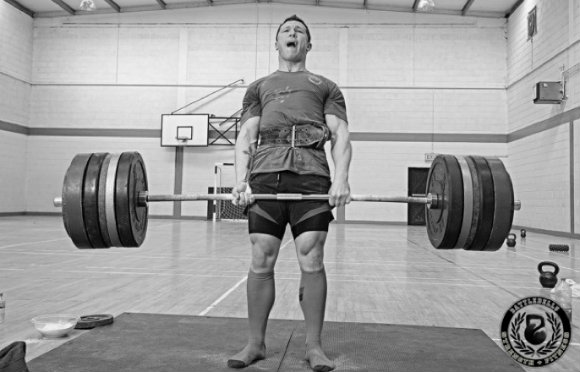
Note: Veteran of Royal Marines Ollie Quinn, SFG II is about to tell you how he trained to win the Men’s Elite Division of the Tactical Strength Challenge. I will add my commentary.
Ollie: When Pavel asked me to write a few words about my recent Tactical Strength Challenge win, I have to say I felt honored, very fortunate, and a little bit worried all at the same time. After all, this was the man who at my first Cert in 2011 gave my training a 180-degree turnaround with a hard style kick up the bee-hind!
The TSC was something I had my eye on for a while, and last April, after more than a few “what ifs” and much deliberation, I went for it. My training plan for the event was simple, probably unique, and definitely convenient.
Deadlifts were performed once or twice per week. If deadlifts were performed twice, the second day was a light day or double overhand axle deadlifts. If performed once, the deadlifts were exchanged with Atlas stone loads to a platform.
Master SFG Dan John uses this type of a deadlift to teach one to squeeze rather than jerk pulls off the platform.
“Atlas stone” lifting is a strongman event. Strongman competitors are well known for their deadlift prowess built through a variety of exercises for the back, midsection, hips, and grip. These are the very same muscle groups emphasized by the TSC.
You must keep in mind that strongman events are known for a high rate of injuries. While very result producing, some strongman lifts and exercises are not optimal ergonomically (like the “Russian hockey deadlift”). Make sure you have perfect mobility and deadlift mechanics before you take on the stones—under expert supervision.
Ollie: The deadlifts were performed in circuit fashion, with a number of other exercises: farmer’s carries, weighted pull-ups, kettlebell military presses, log presses, keg/Atlas stone carries, and dips.
As you’ll see from my circuit below, nearly all the deadlifts are done while fatigued. Circuit training with low reps is a very effective off-season modality for athletes from a lot of sports. Dial in your technique before undertaking it. While you should be limiting your rest between the sets, do not do it at the expense of the weight or skill. Later in the article Ollie adds: “Rest as long as needed.”
Ollie: Most BattleBells [Ollie’s gym] members had at least two days of rest before the event. This circuit led every single person I trained at BattleBells to a deadlift PR at the TSC. Damian Melody pulled 463, Gearod Molloy 451, Shane Sammon 385.8, Patrina O’Brien 220, Lauren O’Malley 253, Vanessa Forde 264, Celine King 286. And last but not least, I managed 551, which I was thrilled with.
Sample Battlebells Circuit
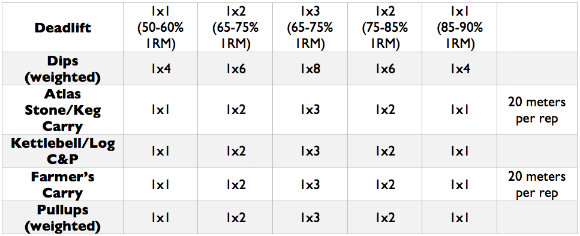 The order of exercises is very important in a strength circuit. One exercise can help or hurt the one before or after, or just be indifferent. For instance, many Soviet Olympic weightlifters did dips after other lifts to decompress their spines. This exactly what Ollie does after his deadlifts. His choice of putting pull-ups before deads is also a solid one—but only because the pull+ups are weighted and low rep. They will not fatigue the grip, lats, or abs but “facilitate” them, make them more awake for the upcoming deadlifts.
The order of exercises is very important in a strength circuit. One exercise can help or hurt the one before or after, or just be indifferent. For instance, many Soviet Olympic weightlifters did dips after other lifts to decompress their spines. This exactly what Ollie does after his deadlifts. His choice of putting pull-ups before deads is also a solid one—but only because the pull+ups are weighted and low rep. They will not fatigue the grip, lats, or abs but “facilitate” them, make them more awake for the upcoming deadlifts.
Circuit notes:
- Start on whatever exercise you like.
- Perform one set of the given reps on one exercise, then move on to the next exercise.
- Rest as long as needed.
- Add sensible amounts of weight each week. You shouldn’t have to summon god to finish any of the reps!
This is freestyle linear cycling. When you train in this manner plan on about six weeks. Work back from a realistic goal.
- Movement prep/warm-up was completed before the circuit started: goblet squats, halos, stick hinges, plank, strict pushups, cobra, swings, etc.
- The circuit was performed Thursdays and Saturdays. Sundays were off. The rest of the training week consisted of joining in the kettlebell class with students on Monday or Wednesday and practicing whatever skills deemed fit on Tuesday. Or, on Monday and Wednesday if not partaking in a class.
Ollie: I attribute a lot of my deadlift success at the TSC to the tension techniques learned at my first kettlebell RKC/SFG Cert.
At a recent StrongFirst seminar 1,000-pound deadlifter Andy Bolton emphasized the importance of tension over and over and over. Because tension equals strength.
Ollie: Walk up to the bar, don’t hesitate or overthink it, pull yourself toward the bar keeping your whole body under tension while inhaling sharply through the nose and squeezing your abs. Look at the wall in front of you, grab the bar, and squeeze the hell out of it. Without a pause, take the slack out of the bar and explode back up, driving your feet into the ground to a total lockout! This grip ‘n rip technique won’t work for everyone. I like it. It gives you less time to overthink the lift, but also less time to look at your set-up. Important thing is that you find one that works for you—and get good at it.
Experience shows that in both powerlifting and weightlifting various types of dynamic start—diving to the bar, rocking several times before the start, etc.—are usually superior for the reasons Ollie lists plus the stretch reflex. But make sure to master a static start first.
Ollie: Pull-ups (weighted) were taken care of at the circuit too, same rep scheme as the deadlifts: 1, 2, 3, 2, 1. I might start with a 20kg bell for 1, then 24kg for 2, 32kg or 28kg for 3, 32kg again but for 2. Depending on how I felt that day I might finish with a 40kg or 44kg single pull-up.
Remember this: if your strength endurance goal is within 20-25 reps, it can be reached by pure strength training alone. You never need to do more than 5 reps in training if your goal is 25.
Once you get above this number—not very likely considering the added weight—then the training completely changes and becomes very complex. Fortunately, a tactical operator does not need these high reps; he trains pull-ups to be able pull himself and his kit up over a wall, etc.
Ollie: I concentrated on speed, and getting my chin as high above the bar as possible. Just like the deadlifts, tension is the key here. If you hang like a rag doll from a pull-up bar and try to do a weighted pull-up with a moderate weight, it’s a nonstarter. I focused on getting a good hollow position, and breaking the bar in half with a thumbless grip before dropping into a dead hang. After a brief pause, I would raise my knees slightly and attempt to chest bump every rep. On the day I completed 14 reps with a 10kg plate attached.
Yes: tension first, speed second. Ollie, you sound like your fellow Brit Andy Bolton. A good company to be in.
Ollie: It’s also worth mentioning here that about a month prior, while preparing for my numerous Beast Tamer attempts, I had completed a grease the groove program from Paul McIlroy, SFG II, which was of huge benefit to my pull-ups.
GTG remains one of the—if not the—most reliable methods of building strength. Its only downside is: not everyone has access to a pull-up bar throughout the day.
Ollie: Finally, I count myself as lucky in that snatches always came fairly natural to me. In preparation for the challenge, apart from some easy snatches with my students, I was only snatching with the 32kg bell once per week. Initially, I started on 5/5 OTMEM (on the minute, every minute) for 5 minutes and worked my way up to a comfortable 8/8 OTMEM with a 32kg bell. This was sufficient to see me to get 100 reps in the 5 minutes for the event.
Simple yet solid strategy. Something you must not overlook is the strength component demanded by 32kg kettlebell snatches. To a strong athlete it feels like a 24kg. Ollie’s deadlift has helped.
Ollie: I was more than happy with that score on the day, but if I were to compete again, I would look to complete a program with a lot more volume, and waving of the load. With a program similar to the one outlined by Jason Marshall in the article section on the StrongFirst website, I’m certain I could find at least 15 more reps.
I highly recommend Jason’s article on TSC preparation.
Ollie: So there you have it, that’s how I did it. No frills. No voodoo. And very enjoyable. Whatever way you prepare, I can’t recommend competing at a TSC highly enough.
Register for the Next TSC
Ladies and gentlemen, SFGs, mark your calendars. October 4 is the next TSC. Nothing like a deadline and a clear goal to supercharge your training!
Read the rules, sign up, and compete.
Are you are ready to host a Tactical Strength Challenge? E-mail our TSC Coordinator, Senior SFG Andrea U-Shi Chang at TSC@strongfirst.com.
5.11 Tactical is sponsoring the event again and there are cool prizes for the winners. Visit the 5.11 online store to appreciate the quality of their products.
I will write personalized deadlift or pull-up programs for the twenty people whose names will be randomly drawn from the first 100 registrants.
Sign up today. Up your training tomorrow.
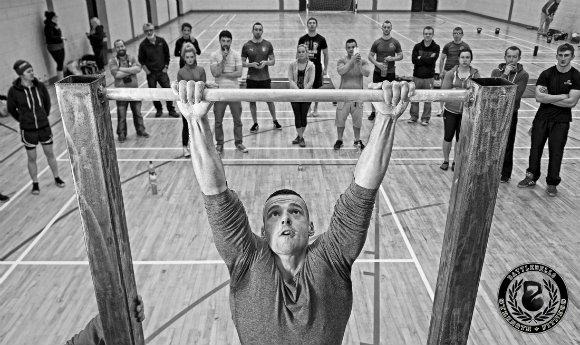
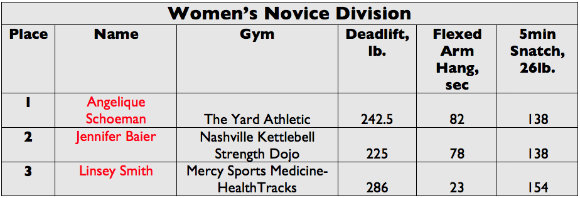


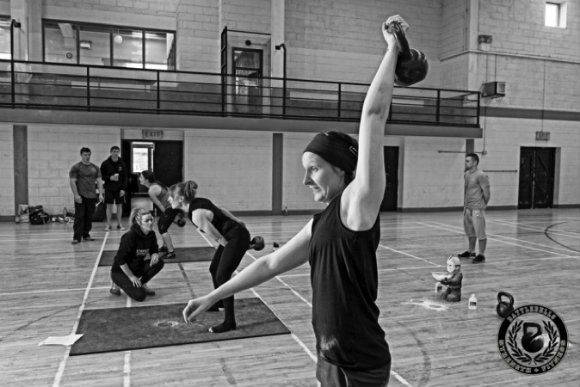



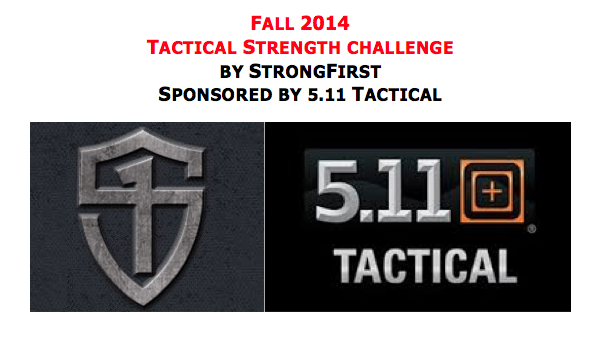
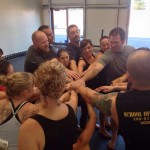




Where can I find past results? I competed in 2007 and 2009.
Thanks
Great write up, guys. Ollie, thanks for such a detailed glimpse at how you prepared. I have one question.
“Deadlifts were performed once or twice per week. If deadlifts were performed twice, the second day was a light day or double overhand axle deadlifts. If performed once, the deadlifts were exchanged with Atlas stone loads to a platform.”
Does this mean you’d do the above circuit twice a week? If you only did it once, by exchanging deadlifts with atlas stone lifts to a platform, does that mean you’d do the two movements back to back?
Thank you James Orr, I only realized people had commented on this now.
The circuit is done twice per week. Thursdays and Saturdays.
So on Saturdays you’d start with Atlas stones, then Dips, Axle deadlift, Kettlebell or log press, farmers carry and weighted pull-ups.
Basically I just avoid doing heavy deadlifts on the same day as atlas stones.
I hope this answers your questions,
Ollie
Great stuff. I was thrilled to see a gym hosting a TSC in Iowa. This is the first year I’ve found one. I’m all signed up and excited for it.
Well, I am tempted to follow such a well-defined workout program to get the best possible results! I agree that when you’re doing chin-ups, all you need to focus on is the speed, rhythm and proper posture. If your position is perfect, you can never fail to keep your chin well above the bar every time you go up! I am impressed that you were able to complete 14 reps and that too with a 10-kg plate attached!
Thanks Ollie and Pavel
Really good insight into programing for the TSC.
Thank you, Rickard!
I liked this article. It was built in a nice way with the commentary from Pavel explaining alot of things I would have otherwised missed. Shows I have a lot to learn. Thank you.
Thanks Rickard,
Yes, Pavel has a way of making you understand things that no other man can emulate 🙂